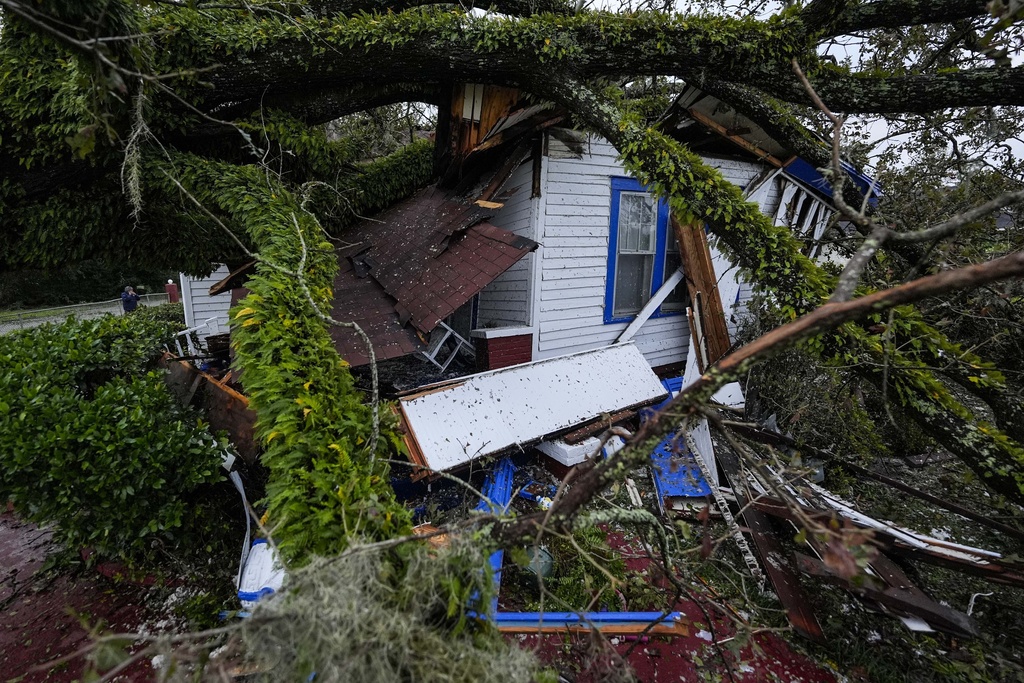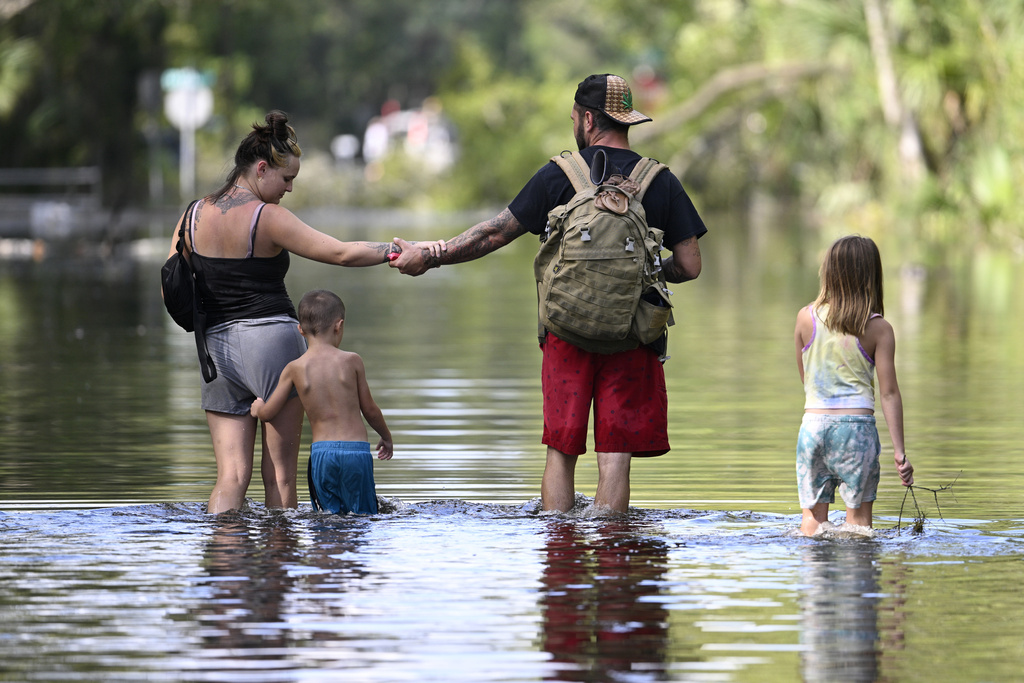Can Humans Control Hurricanes? Climate Change Makes It Harder \ Newslooks \ Washington DC \ Mary Sidiqi \ Evening Edition \ Hurricane Milton’s rapid approach to Florida shortly after Hurricane Helene has some people questioning the possibility of human influence over weather. Conspiracy theories aside, humans have a limited capacity to influence hurricanes, which release an extraordinary amount of energy. Historical attempts to control them have failed, but some scientists are looking at geoengineering solutions to combat climate change. However, these ideas raise ethical and practical concerns.

Can We Control Hurricanes? Quick Looks
- Hurricanes release energy equivalent to a 10-megaton nuclear bomb every 20 minutes.
- Climate change is making hurricanes more intense, but humans still can’t control them.
- Past efforts, like Project STORMFURY, failed to weaken hurricanes or control their paths.
- Geoengineering may hold promise for mitigating climate change, but it’s still far off.
- The best solution is reducing greenhouse gas emissions to address the root causes of stronger storms.
Deep Look:
Hurricanes like Milton, which is barreling toward Florida just days after Hurricane Helene caused widespread devastation, remind humanity of the awesome, uncontrollable power of nature. With back-to-back storms striking the same regions, it’s natural for some to wonder whether humans can influence or control these weather patterns. Unfortunately, some corners of the internet have taken these questions further, sparking conspiracy theories claiming that hurricanes are intentionally directed or amplified to target certain populations.
In reality, these theories disregard the complex science of hurricanes, which have been hitting many of the same coastal areas for centuries. The notion that humans can manipulate or direct such storms also ignores the fundamental unpredictability and immense power behind these natural phenomena. As Kristen Corbosiero, a professor of atmospheric and environmental sciences at the University of Albany, explains, “If meteorologists could stop hurricanes, we would stop hurricanes. If we could control the weather, we would not want the kind of death and destruction that’s happened.”
The Unmatched Power of Hurricanes, Heightened by Climate Change
Hurricanes are among the most powerful forces on Earth. A fully developed hurricane releases heat energy equivalent to a 10-megaton nuclear bomb every 20 minutes—more energy than all of humanity consumes in that time, according to Chris Landsea, a chief analyst at the National Hurricane Center. This immense energy is drawn from the warm ocean waters and fueled by the rising air in the storm’s center.
Climate change has made hurricanes more destructive. Warmer oceans fuel more powerful storms, while the warming atmosphere holds more moisture, increasing the rainfall from hurricanes. “The amount of energy a hurricane generates is insane,” says Phil Klotzbach, a researcher at Colorado State University. He stresses that it’s the height of human arrogance to think we can influence or control hurricanes on a meaningful scale.
Historical Efforts to Control Hurricanes Have Failed
Humans have been fascinated by the idea of controlling weather for centuries, but so far, all efforts to influence hurricanes have failed. Jim Fleming, a historian at Colby College, has studied past attempts and remains skeptical of future possibilities. One of the earliest efforts to weaken hurricanes occurred in 1947, when General Electric partnered with the U.S. military to drop dry ice from airplanes into a hurricane’s path, hoping to disrupt its development. The experiment did not work.
Another significant attempt to control hurricanes came during the 1960s to 1980s with the federal government’s Project STORMFURY. The goal was to “seed” hurricanes—replacing the storm’s eyewall with a larger one in order to weaken its intensity. While scientists conducted several tests, results were inconclusive, and the project eventually ended. Researchers realized that expanding the size of the storm could endanger people who would otherwise be unaffected, presenting serious ethical and liability issues. As the project director noted, creating a larger storm is a double-edged sword—though it might reduce wind speed, it risks placing more people in the storm’s path.
One of the most persistent, yet scientifically unfeasible, ideas is the concept of using nuclear bombs to stop hurricanes. This idea has been proposed many times over the decades but quickly dismissed by experts. As Corbosiero explains, nuclear bombs are not nearly powerful enough to disrupt a hurricane’s energy, and such an action would only create additional problems, such as radioactive fallout.
Ideas like towing icebergs to cool ocean waters or using water-absorbing substances to limit rainfall have also been considered. However, scientists at the National Oceanic and Atmospheric Administration (NOAA) have concluded that none of these proposals are practical solutions.
Future Geoengineering Ideas and Their Challenges
While historical attempts to control hurricanes have failed, some scientists are exploring modern geoengineering techniques to combat climate change and its influence on extreme weather events. The primary difference between these efforts and earlier hurricane-targeted ideas is that geoengineering focuses on global-scale changes, rather than attempts to control individual storms.
One of the most promising geoengineering concepts is solar radiation management, which involves injecting aerosol particles into the upper atmosphere to reflect sunlight away from the Earth, thereby cooling the planet. David Keith, a professor at the University of Chicago and an expert in climate systems engineering, acknowledges the risks of this approach but believes it could offer substantial benefits, particularly for the world’s poorest populations, who are most vulnerable to climate change.
Nevertheless, the ethical and environmental concerns surrounding geoengineering are significant. Many scientists, like Pennsylvania State University climate expert Michael Mann, warn that any attempts to manipulate Earth’s atmosphere on such a scale could lead to unforeseen and potentially catastrophic side effects. Mann also raises concerns about the ethics framework being developed by organizations like the American Geophysical Union (AGU). He worries that simply discussing the guidelines could make geoengineering more likely to happen, despite the fact that the technology is still decades away from practical use.
Chris Field, director of the Stanford Woods Institute for the Environment, agrees that while geoengineering has potential, it should be considered a last resort. He emphasizes that the most effective way to mitigate the worsening effects of hurricanes and other extreme weather events is to reduce greenhouse gas emissions. “Whatever else we do, that needs to be the core set of activities,” he said.
The Best Solution: Mitigating Climate Change
While humans have limited capacity to control or influence hurricanes, there is a broader issue that we can address: climate change. Reducing emissions of greenhouse gases will help slow the rate of warming oceans and the atmosphere, mitigating the frequency and intensity of hurricanes. Although geoengineering may one day play a role in addressing climate change, scientists agree that the focus should be on prevention, not retroactive fixes.
As Hurricane Milton looms over Florida, and as extreme weather events become more frequent and severe, humanity’s best course of action remains reducing its impact on the climate through sustainable practices, renewable energy, and global cooperation. Weather, in its rawest form, remains uncontrollable, and efforts to influence it have only highlighted our limitations.







